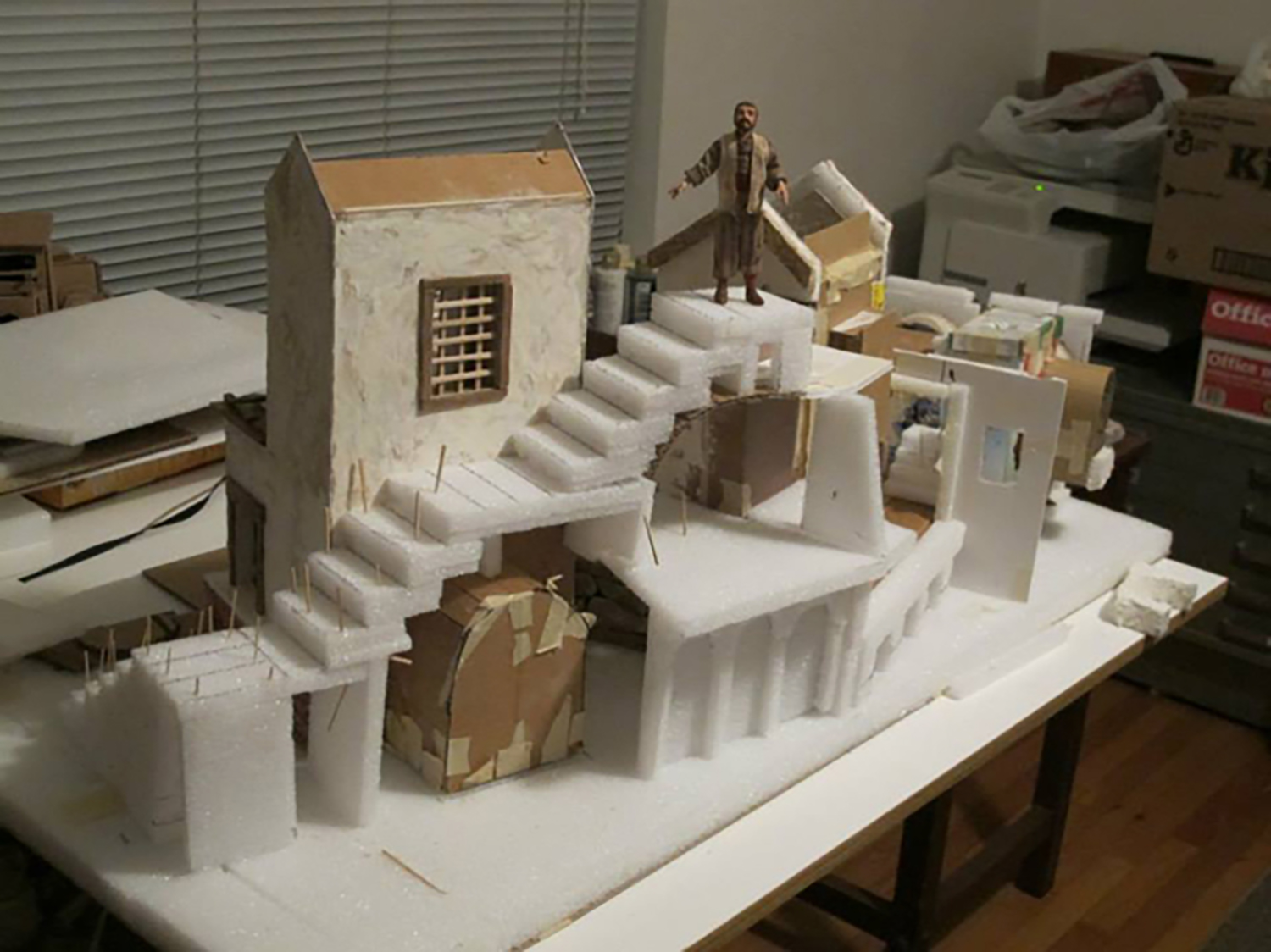Glencairn Museum News | Number 12, 2013
American Presepio by Karen Loccisano and R. Michael Palan.
Figure 1: Karen Loccisano and R. Michael Palan with their Presepio during its construction.
Why build a Presepio? According to Michael, “We wanted to work on a large scale project together. We were drawn to the Angel Tree and the Neapolitan figures surrounding it at the Metropolitan Museum of Art in New York City.” The Met’s 18th-century Neapolitan Presepio is exhibited annually beneath their Christmas tree. According to the museum’s website, “The origin of the popular Christmas custom of restaging the Nativity traditionally is credited to Saint Francis of Assisi. The employment of manmade figures to reenact the hallowed events soon developed and reached its height of complexity and artistic excellence in eighteenth-century Naples. There, local families vied to outdo each other in presenting elaborate and theatrical crèche displays, often assisted by professional stage directors. The finest sculptors of the period—including Giuseppe Sammartino and his pupils Salvatore di Franco, Giuseppe Gori, and Angelo Viva—were called on to model the terracotta heads and shoulders of the extraordinary crèche figures.”
Figure 2: The Holy Family.
Karen adds, “We started learning about the characters, symbolism and traditions of the Neapolitan Presepio. Presepio means crib in Italian. It connects God with the common man by including the Holy Family and an entire 18th-century village of everyday people. The more we learned, the more excited we became about creating our own version.”
Karen grew up in Bridgewater, New Jersey, and Michael is from Northeast Philadelphia. Professionally they have both worked as illustrators for children’s publications. (In fact, the couple first met at an illustrators’ party given by Highlights for Children magazine). For the past decade they have been working together designing Christmas ornaments for Kurt S. Adler, Inc.
Figure 3: R. Michael Palan working on one of the structures for the Presepio.
Michael, who crafted the architecture, furniture, and most of the details in the scene, says he has “always enjoyed architecture and buildings.” He once made a Christmas village for Kurt S. Adler, Inc., and has built a detailed miniature hilltop village Nativity, which is now part of a large international collection. Recently he was commissioned to build a Flemish stable for a collection of 18th-century créche figures.
Figure 4: Materials consisting of lightweight Styrofoam, cardboard, and wood are used to create the structures.
The scale of the Presepio is roughly one inch to one foot. The materials for the buildings and landscape are simple, consisting mostly of lightweight Styrofoam, cardboard, and wood. Although it has the look of stone, the village is very lightweight. The heads, hands and feet of the figures are sculpted in polymer clay, and the bodies are poseable, made from wire wrapped in yarn.
Figure 5: The three wise men and an attendant surrounded by the materials that will be used to dress them. Special silks were ordered from India.
Karen sculpted and dressed the 24 human figures in the Presepio. “As I sculpt, I think about the personality I want the figures to have. Sometimes my ideas change as I’m working. I am inspired by people I know and things I see. For the costumes, I look at historical references, and then make a small paper pattern. I have collected material over the years, but for the Magi I ordered silk online from India. Their clothes are trimmed with antique metallic lace that I found in New York City. Michael had been posting the process on Facebook and a friend sent me a much needed box of fabric. She also sent wood for Michael to build furniture.”
According to Michael, “In Italy, families purchase additional pieces for their Nativity every year. The Nativity is always growing. We intend for ours to do the same.”
Figure 6: The fruit seller looks very familiar, having been designed by Karen to look like Michael.
“Our favorite scene was constantly changing as we were working. The addition of another figure, bucket, cat, or vegetable brought new life to a scene,” said Karen. Karen’s favorite figure is the vegetable seller, “because it looks like Michael.” Michael says his favorite figure is also the vegetable seller—“because he’s so handsome.”
For more information about Glencairn's World Nativities exhibition this year, see the November issue of Glencairn Museum News.
(CEG)
A complete archive of past issues of Glencairn Museum News is available online here.







